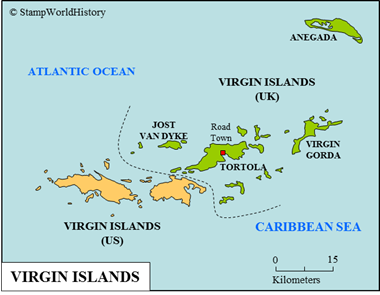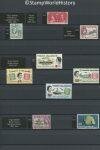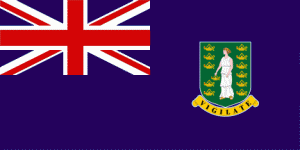
Virgin Islands
Quick reference
General issues: British colony/Presidency Leeward Islands 1866-1960, British colony 1960-1967, British colony/Self government 1967-1981, British dependency 1981-2002, British overseas territory 2002-Present
Country name on general issues: Virgin Islands, British Virgin Islands
Currency: 1 Pound = 20 Shilling, 1 Shilling = 12 Pence 1866-1951, 1 Dollar= 100 Cents 1951-Present
Population: 5000 in 1901, 28 000 in 2010
Political history Virgin Islands
The Virgin Islands is located in the Caribbean and is part of the Virgin Islands archipelago that, in itself, is part of the Lesser Antilles. For the exact location, please refer to the map of the Caribbean. Although the official name of the country is Virgin Islands, it is often called British Virgin Islands to distinguish it from the neighboring United States Virgin Islands that are also part of the Virgin Islands archipelago. Archaeological finds show proof that the islands, prior to colonization, have been inhabited by the Amerindian Arawak and Carib peoples that are found on many of the Lesser Antilles. Records of first exploration and settlement suggest that the islands were uninhabited at time of colonization. The first European to sight the islands was Christopher Columbus in 1493. Columbus claimed the islands for Spain but the Spanish never settled the islands. Throughout the 16th and 17th centuries, the islands were contested by the British, the Danish, the Dutch, the French and the Spanish. Having settled on the main island of Tortola in 1671, the British would, eventually, gain permanent possession of the islands that currently constitute the British Virgin Islands. The colony of the Virgin Islands was established in 1713. The neighboring islands, that now constitute the United States Virgin Islands, became a Danish possession as the Danish West Indies.
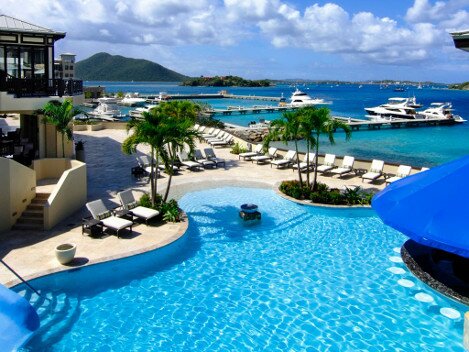
Off shore financial services and tourism are the mainstay of the Virgin Islands economy. Tourism accounts for 45% of the national income.
From the 17th until the 20th century, the Virgin Islands were, almost continuously, administered as part of the Leeward Islands colony – the federal colony that grouped together the British possessions in the Leeward Islands. Between 1871 and 1960, the Virgin Islands were formally designated as a presidency of the Leeward Islands. After the Leeward Islands colony was dissolved, the Virgin Islands became a separate colony in 1960 and achieved self government in 1967. As did other British possessions throughout the world, the Virgin Islands became a British dependency in 1981 and a British overseas territory in 2002.
Economically, the British developed plantations, with sugar cane as the main crop, in the 18th century. To man the plantations, slaves were brought to the islands and they soon outnumbered the planters of European descent. After the abolition of slavery in 1834 and because of increased competition and decreasing prices, the sugar cane production went into decline. The Virgin Islands, in the second part of the 19th and the first part of the 20th century, was economically little developed. Fortunes changed in the second part of the 2oth century, as tourism and off shore financial services were developed. The Virgin Islands is currently one of the leading centers for off shore financial services – home to the largest number of off shore companies in the world. In terms of per capita GDP the Virgin Islands ranks among the richest countries in the Caribbean. The majority of the population – 82% – is black with minorities of whites and people of mixed and East Indian descent.
Postal history Virgin Islands
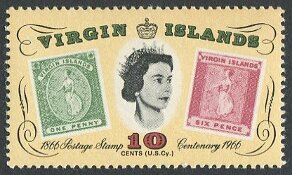
1966 – Postage stamp centenary. Note the first issue of the Virgin Islands showing Saint Ursula, the patron saint of the islands.
The first stamps used in the Virgin Islands are the general issues from Great Britain, which were used between 1858 and 1860. The first stamps for the Virgin Islands were issued in 1866. This first issue shows Saint Ursula, the patron saint of the islands. Between 1890 and 1899, the stamps of the Leeward Islands are used exclusively. From 1899, the Virgin Islands again issued stamps that were, until 1956, used concurrent with the issues of the Leeward Islands. Throughout the classical era, relatively few stamps were issued – from 1904, mainly designs common to the British colonies. The Virgin Islands have participated in several of the omnibus issues for the British colonies. In the modern era, stamp production increased – the stamps issued being a blend of designs with themes of national interest and themes aimed at the thematic collectors market. The issues of the Virgin Islands were inscribed ‘Virgin Islands’ between 1866 and 1968 and ‘British Virgin Islands’ from 1968 until today.
Album pages
← Previous page: VenezuelaNext page: Anguilla →

